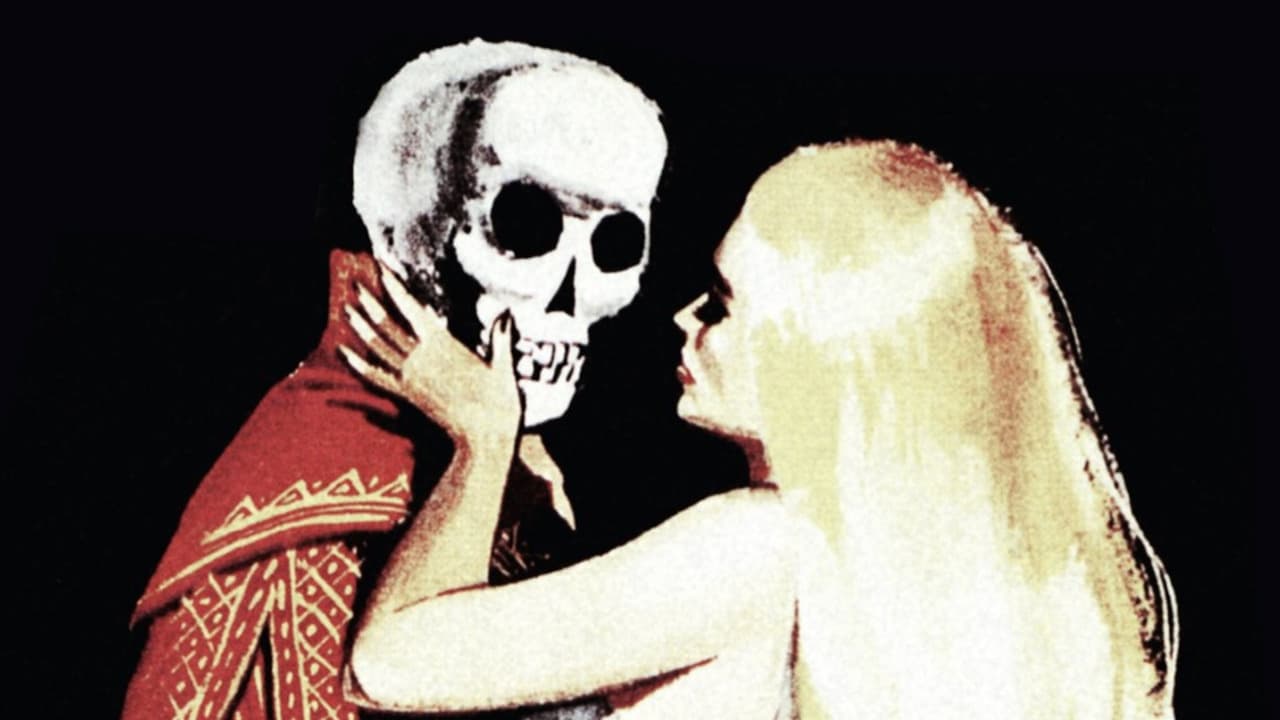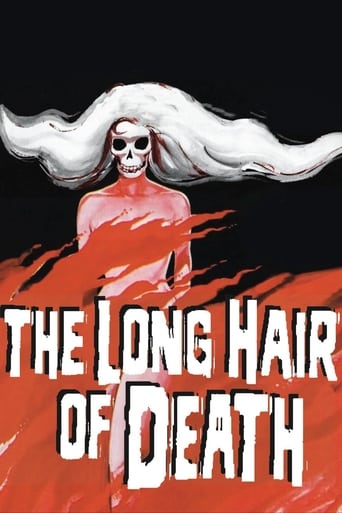Lucybespro
It is a performances centric movie
Myron Clemons
A film of deceptively outspoken contemporary relevance, this is cinema at its most alert, alarming and alive.
Scarlet
The film never slows down or bores, plunging from one harrowing sequence to the next.
ferbs54
In a taped interview that she gave at Toronto's Festival of Fear 2009, cult actress Barbara Steele mentioned that of her 40-odd films, only 11 have been in the field of horror (the clip is currently viewable on YouTube), the inference being that Babs today wonders just WHY her legion of fans insists on calling her "the Queen of Horror." By my count, however, Steele has appeared in at least 14 horror pictures, and is perhaps best remembered for the string of nine Italian Gothics that she appeared in, from her breakthrough appearance in the 1960 Mario Bava masterpiece "Black Sunday" to 1966's "An Angel for Satan." The picture in question here, "The Long Hair of Death" (just one of eight films that Steele appeared in in 1964!), is a perfect demonstration, however, of just why Steele remains the undisputed Queen of Horror to this day, despite her pooh-poohing of the title.In the film, as in several of her others, Babs plays what are essentially two roles. In the late 1400s, in what seems like a Germanic kingdom, young Helen Karnstein (our Barbara) sees her mother burned as a witch (interestingly, NOT at the stake, but rather at the center of a ring of entwined branches). The cruel nobleman Kurt Humboldt (very well played by handsome George Ardisson) had recently killed his own uncle and blamed it on this supposed daughter of Satan, but Helen's dreams of vengeance are cut short when Kurt's father, the Count (Giuliano Raffaelli), kills her shortly thereafter by tossing her down a waterfall! Flash forward 10 years or so, and Helen's sister, Elizabeth (Halina Zalewska, who looks very much to me like Kirstie Alley, of all people!), also harboring thoughts of a long-deferred vengeance, is forced into an unholy marriage by Kurt, the very man who killed her mother! And shortly after, on a stormy night, a woman named Mary, the spitting image of the deceased Helen (Babs again, natch), appears at the castle door, capturing the fickle Kurt's heart and paving the way for poisonings, deceit and assorted mayhem...."The Long Hair of Death" (the title is triply significant!) was the second collaboration between Steele and director Antonio Margheriti; their first, the truly spooky "Castle of Blood," had been released earlier that same year. In both films, Margheriti exhibits a definite flair for these Gothic affairs, and he is hugely abetted here by the art direction and set design of, respectively, Giorgio Giovannini and Henry Fraser. The castle chambers and underground crypts on display in the film are things of morbid and dreary beauty, wonderfully shot in B&W by cinematographer Riccardo Pallottini (who had also served as the DOP on "Castle of Blood"). And while I'm name-dropping, I may as well add that the truly creepy score by famed composer Carlo Rustichelli (who, that same year, worked on Mario Bava's protogiallo "Blood and Black Lace") adds immeasurably to the sinister goings-on, despite the fact that it IS repeated at least a dozen times during the course of the picture. The film features any number of startling sequences--including several burnings and the awesome sight of Babs' decayed corpse being reanimated in her newly opened grave by lightning--and various gross-out shots (Babs' maggot-filled corpse face, reminiscent of the puss she sported in "Black Sunday" as the witch Asa, as well as a skeleton being jittered by some frisky rodents). There is also a surprising flash of toplessness on display here (again, as in "Castle of Blood"), probably thanks to Barbara's body double, and I must add that the vengeance that the two sisters ultimately wreak on Kurt is a doozy, prefiguring a classic scene in 1973's "The Wicker Man" by almost a decade. Essentially an exemplar of the Italian Gothic, "The Long Hair of Death" has both style and atmosphere to spare, and is of course stolen by the magnificent Barbara Steele, who is both captivating and beautiful in every scene that she graces. And how chilling she is, when she appears to Kurt near the film's end and intones "You're going to die"! Wonderful stuff, indeed! The further good news is that this film can now be found in a nice-looking print (although poorly dubbed) on a DVD from a company known as Midnight Choir...AND paired with the Steele rarity "An Angel for Satan," her last Italian Gothic! Watching these two films together will certainly satisfy any viewer that, despite her denial in Toronto, Barbara Steele really IS the Queen of Horror!
Woodyanders
The 15th century. A woman who's been falsely accused of being a witch gets burned at the stake. Her daughter Helen Karnstein (a fine performance by ravishing brunette scream queen cult favorite Barbara Steele) vows revenge, but is shoved off a cliff to her death by the wicked, yet weak Count Humboldt (a solid turn by Guiliano Raffaelli). Several years later Helen comes back from the dead as alluring lookalike Mary in order to bring both Count Humboldt and his even worse, more evil and corrupt son Kurt (a deliciously villainous and revolting portrayal by George Ardisson) to justice. Director Antonio Marghereti, who also co-wrote the compelling script with Bruno Valeri, does an expert job of creating and sustaining a potently brooding gloom-doom midnight-in-the-graveyard sepulchral atmosphere; the extremely strong and unsettling sense of bleak nightmarish dread really gets under the viewer's skin and culminates in an exciting confrontation between Helen and Kurt with an ultimate chilling resolution which neatly prefigures "The Wicker Man." Moreover, Margheriti stages Helen's resurrection from her grave by a bolt of lightning with real bravura aplomb and makes excellent use of the gorgeous rural sylvan countryside. Steele excels in her dual role; she receives fine support from the lovely Halina Zalewski as her faithful sister Elizabeth, Umberto Raho as honest priest Von Klage, and Laura Nucci as loyal housekeeper Grumaldi. Riccardo Pallottini's crisp black and white cinematography boasts several nifty prowling camera pans. Carlo Rustichell's supremely spooky'n'shuddery score likewise hits the shivery spot. Well worth seeing for both Barbara Steele fans and Italian Gothic horror buffs alike.
wes-connors
"A woman is put to death after bring accused of witchcraft. Her daughter confronts the man who accused her mother of the crime, and discovers the true reason for the accusation, but loses her life in doing so. The youngest daughter is taken in by the man's family and raised by them, with the intent to marry her off to the man's son. When the girl comes of age, her decreased sister returns to exact her revenge upon the family," according to the DVD sleeve's synopsis."This story takes place at the end of the fifteenth century," we are advised. Director Antonio Margheriti and the crew give it a great look. That, an attractive cast, and the moody atmosphere can't make up for the fact that the film plays itself out very slowly, and winds up nowhere special. Barbara Steele (as Mary / Helen Karnstein) looks particularly stunning; probably, she inspired the US title: "The Long Hair of Death" (but, what a way to go). Strange how drastically Halina Zalewska (as Elizabeth Karnstein) changes her mind about George Ardisson (as Kurt Humboldt), after Ms. Steele (re)emerges on the scene.**** I lunghi capelli della morte (1964) Antonio Margheriti ~ Barbara Steele, George Ardisson, Halina Zalewska
The_Void
Well, it's obvious that The Long Hair of Death takes a lot of its influence from the Mario Bava masterpiece 'Black Sunday', but even so; Antonio Margheriti's film manages to deliver a good horror story in its own right. The plot is pretty much your classic Gothic horror yarn, and focuses on a small village. A woman is accused of being a witch and promptly put to death. However, her eldest daughter knows the real reason for her death revolves around the lord, and she's promptly killed also. The youngest daughter survives and is taken in by the murderous lord's family, eventually marrying his son. Soon after, a deadly plague threatens the village; and the older daughter reappears to avenge her mother's death. The main standout of this movie is definitely the atmosphere - director Antonio Margheriti does an excellent job of giving the movie a foreboding feel through the eerie black and white cinematography and the imposing sets. The plot can drag a bit at times, which is a shame; and so it's lucky that Margheriti was able to give the film an atmosphere as it keeps it going when the plot takes a downturn.Another standout about this film is, of course, the fact that it has a leading role for Barbara Steele. Of course, she was almost certainly cast because of her success in Black Sunday, and as such; this isn't her greatest performance, but she's always nice to see and she does play the resurrected woman well. It does quite often seem like Margheriti is dragging the plot out and this is a shame as the film is overlong as a result and it has to be said that The Long Hair of Death would have benefited from a shorter running time. Antonio Margheriti made some good films in his career, though the fact that he doesn't get good recognition along with the likes of Sergio Martino and Lucio Fulci doesn't surprise me. This film was released in between Margheriti's successes with The Virgin of Nuremberg and Dance Macabre, and although I prefer both of the mentioned films; this one is still worth seeing for the Italian Gothic horror fan. The film boils down to a somewhat predictable ending, but it's a nice ride getting there and overall, despite the fact that The Long Hair of Death may not be the most successful film of it's type - it's still worth a watch.

